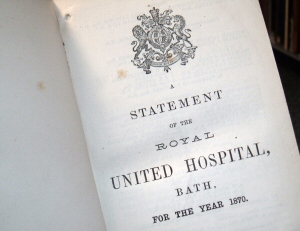About Us
History
A Potted History of the RUH
 Before the 18th Century, hospitals in the sense we recognise them today were unknown, and with a population of under 2,000 at the start of the century, Bath was hardly big enough to need one anyway.
Before the 18th Century, hospitals in the sense we recognise them today were unknown, and with a population of under 2,000 at the start of the century, Bath was hardly big enough to need one anyway.
All that changed with the spectacular Georgian redevelopment of the city which began in the 1700s. The population soared, the city's fame as a health resort grew and medical facilities of some kind quickly became a necessity. The city's first hospital, the Bath General Infirmary (now the Royal National Hospital for Rheumatic Diseases), opened in 1742, but was only open to visitors from outside the city. So if you were unlucky enough to contract a disease or suffer an accident, it was just too bad if you happened to live in Bath.
Fortunately the public-spirited citizens of Bath, concerned at poverty and disease in the poorer parts of the town were willing to use their resources to put matters right and formed the Bath Pauper Trust in 1747 to raise money for people needing medical advice and assistance. They based their services in a 'Dispensary' in Wood Street which later moved to Lower Borough Walls and became known as the Bath City Infirmary and Dispensary.
By the end of the 18th Century the Infirmary was treating around 1,500 outpatients and 120 inpatients a year.
The scale of Bath's building boom created a heavy demand for an accident and emergency service, and in 1788 a new casualty hospital opened in Kingsmead Street, creating healthy competition between itself and the Infirmary.
However, these two small hospitals were deemed inefficient and costly and plans were made for a merger. This new combined institution, sited between Lower Borough Walls and what is now Beau Street, was named the Bath United Hospital and opened in 1826. With growing demand for its services the building of an additional wing, named the Albert Wing after the recently deceased Prince Consort, commenced in 1864. This prompted Queen Victoria to bestow the title 'Royal' upon the hospital, and for the first time it became known as the Royal United Hospital.
As the 20th Century dawned, advances in medical techniques, coupled with rising demand for the hospital's services were putting pressure on the old building and thoughts turned to a new site - Combe Park, the present site of the Royal United Hospital, which opened on December 11 1932.
Throughout its history the hospital has been dependent on charity often coming from surprising sources. One of the earliest donations was the Batheaston Vase, a large ornament brought from Italy to Batheaston by Sir John Miller, President of the Pauper Trust. The fashionable folk of Bath were asked to join a poetry competition and put their entries into the vase. Some of these poems were later sold for the benefit of the Pauper Trust and the first installment of £10 arrived in 1776!
In its early years most of the money for maintaining the RUH came from wealthy residents of the city whose annual subscriptions entitled them to vote in public elections for the doctors who worked at the hospital. Every year these subscribers were also allocated 'tickets of relief' according to how much they had contributed, and they would in turn hand these out to those they considered most in need of treatment. This ticket system lasted until 1905 when it was decided that admission should be authorised by doctors instead.
This didn't please everyone and definitely alienated some subscribers who felt that they were losing the privilege of bestowing their charity (and their power) on poorer people. So it was decided that, though patients would be admitted in future at the discretion of hospital authorities, subscribers of five shillings upwards could still send letters of recommendation if they really wanted to.
However, at this point the type of subscriber had changed. In the first part of the 1800s there had been large donations from churches, from collecting boxes in all the fashionable meeting places, and also from many titled people, but income tax and the introduction of death duties reduced the number of wealthy residents and the amounts of cash given. By 1900 a large proportion of the funding came instead from pubs, from various local businesses, and from working men's associations.
Proceeds were donated to the hospital from such functions as the Bachelors' Ball, from drama shows and from Penny Readings. Penny Readings were talks, on all sorts of subjects, generally given in church halls. One penny was charged for admission and the proceeds went to the RUH. In the early 1900s large amounts were sent in regularly by Bath Cycling Club - so much that a representative of the club was given the unusual honour of being elected to the hospital committee.
Other donations include a woman who sent half a five pound note and promised the other half a week later because she didn't trust the postman. In 1787 one guinea was given by William Wilberforce of anti-slavery fame. Queen Victoria's mother sent £25 in 1830 and £10 came from Empress Eugenie of France, who was at the time living in exile in England.
Landowners sent donations from fines they imposed on men found poaching and magistrates directed fines imposed for various crimes such as women who stole flowers from Victoria Park and even a man found fishing in the Park's lake. There are also two or three different cases over the years which are described as 'compensation for slander' - the people of Bath were obviously a gossipy lot!
Larger amounts came from legacies, but the wills sometimes stipulated that the hospital must maintain the graves and tombstones of the deceased and up until 1948, ie the birth year of the NHS, the RUH was responsible for graves as far away as London, Hythe and Brighton.
The birth of the National Health Service signalled the start of a period of progressive expansion in hospital services everywhere, and the RUH was no exception. In 1959, 120 years after its foundation, the Ear Nose and Throat Hospital in Marlborough Buildings closed and transferred to the RUH. Bath Eye Infirmary in Lansdown, whose history encompassed 162 years and four changes of address, followed suit in 1973.
In 2014 maternity services were transferred to the RUH and in 2015, the Bath based Royal National Hospital for Rheumatic Diseases became part of the RUH, securing the future of the RNHRD's high quality services and ensuring patients in the area and beyond can continue to access world class care and expertise.
This short summary shows that the Royal United Hospital's history has been a long and colourful one, with a common thread running throughout - a determination by those in charge to provide the care the people of Bath have needed, regardless of prevailing problems. History continues to be written. The next few years will bring a new milestone in the story of the RUH - as a multi-million pound redevelopment changes the shape of the hospital.
We are grateful to Kate Clarke for helping to compile this article.


